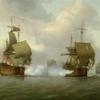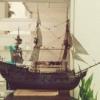-
Posts
27 -
Joined
-
Last visited
Reputation Activity
-
 1492 got a reaction from Obormotov in MONTAÑES by Amalio
1492 got a reaction from Obormotov in MONTAÑES by Amalio
Amalio
Very nice work.
You're not going to include cannons to lower deck?
No vas a incluir cañones?
-
 1492 got a reaction from Eddie in Wood Suppliers in Australia
1492 got a reaction from Eddie in Wood Suppliers in Australia
I thought I'd start this topic for places to get wood for our Australian members.
The one I have used previously is Trend Timbers. They have a great selection of many different local, imported and exotic timbers. Their staff is very helpful even though I felt I may have been wasting their time with my minor needs.
-
 1492 got a reaction from tasmanian in What do you use your mill for ?
1492 got a reaction from tasmanian in What do you use your mill for ?
I have been following this topic with interest and it reminded me of some old pictures I kept on my PC from the MSW 0.1.
I know this is slightly off topic but thought it may be interesting for those interested in making cheapo profile mill bits.
These were from the build log of the Panteleymon by Russian master builder Alex Baranov. It is a pictorial tutorial that may come in useful to some:
-
 1492 got a reaction from riverboat in Why not paint your ship?
1492 got a reaction from riverboat in Why not paint your ship?
Why not use both? This is an old photo of my version of AL's Swift. I use paint for bulwarks, wales and masts (not shown). Then I tried to blend the finishes so it looks 'natural'.
-
 1492 got a reaction from ZyXuz in What do you use your mill for ?
1492 got a reaction from ZyXuz in What do you use your mill for ?
I have been following this topic with interest and it reminded me of some old pictures I kept on my PC from the MSW 0.1.
I know this is slightly off topic but thought it may be interesting for those interested in making cheapo profile mill bits.
These were from the build log of the Panteleymon by Russian master builder Alex Baranov. It is a pictorial tutorial that may come in useful to some:
-
 1492 got a reaction from Landlubber Mike in Why not paint your ship?
1492 got a reaction from Landlubber Mike in Why not paint your ship?
Why not use both? This is an old photo of my version of AL's Swift. I use paint for bulwarks, wales and masts (not shown). Then I tried to blend the finishes so it looks 'natural'.
-
 1492 got a reaction from avsjerome2003 in Why not paint your ship?
1492 got a reaction from avsjerome2003 in Why not paint your ship?
Why not use both? This is an old photo of my version of AL's Swift. I use paint for bulwarks, wales and masts (not shown). Then I tried to blend the finishes so it looks 'natural'.
-
 1492 got a reaction from Martin W in What do you use your mill for ?
1492 got a reaction from Martin W in What do you use your mill for ?
I have been following this topic with interest and it reminded me of some old pictures I kept on my PC from the MSW 0.1.
I know this is slightly off topic but thought it may be interesting for those interested in making cheapo profile mill bits.
These were from the build log of the Panteleymon by Russian master builder Alex Baranov. It is a pictorial tutorial that may come in useful to some:
-
 1492 reacted to WackoWolf in What do you use your mill for ?
1492 reacted to WackoWolf in What do you use your mill for ?
1492,
I remember that post from MSW 1 and I also have those pictures plus some others. Thanks for posting them for everyone that has never seen them.
Janos, Thank you for posting your also. This should be a great help for anyone that wants to try and make their own bits.
Thanks guys.
-
 1492 got a reaction from janos in What do you use your mill for ?
1492 got a reaction from janos in What do you use your mill for ?
Thanks Janos, That's really good information, I appreciate your help because I've had these photos for a while and no other instructions to go by.
-
 1492 got a reaction from sonicmcdude in What do you use your mill for ?
1492 got a reaction from sonicmcdude in What do you use your mill for ?
I have been following this topic with interest and it reminded me of some old pictures I kept on my PC from the MSW 0.1.
I know this is slightly off topic but thought it may be interesting for those interested in making cheapo profile mill bits.
These were from the build log of the Panteleymon by Russian master builder Alex Baranov. It is a pictorial tutorial that may come in useful to some:
-
 1492 got a reaction from tkay11 in What do you use your mill for ?
1492 got a reaction from tkay11 in What do you use your mill for ?
I have been following this topic with interest and it reminded me of some old pictures I kept on my PC from the MSW 0.1.
I know this is slightly off topic but thought it may be interesting for those interested in making cheapo profile mill bits.
These were from the build log of the Panteleymon by Russian master builder Alex Baranov. It is a pictorial tutorial that may come in useful to some:
-
 1492 got a reaction from AntonyUK in What do you use your mill for ?
1492 got a reaction from AntonyUK in What do you use your mill for ?
I have been following this topic with interest and it reminded me of some old pictures I kept on my PC from the MSW 0.1.
I know this is slightly off topic but thought it may be interesting for those interested in making cheapo profile mill bits.
These were from the build log of the Panteleymon by Russian master builder Alex Baranov. It is a pictorial tutorial that may come in useful to some:
-
 1492 reacted to DSiemens in Building A Miniature Navy Board Model - Philip Reed
1492 reacted to DSiemens in Building A Miniature Navy Board Model - Philip Reed
This looks like a book I will have to look into. I have been building miniatures and putting them in bottles the last year and a half. I have built two ships with split hull's with the purpose of fitting it in the bottle.
I'm not sure if this is the same as the book or even the same technique. I'll have to get a copy and see.
-
 1492 reacted to Modeler12 in Which scrollsaw
1492 reacted to Modeler12 in Which scrollsaw
Here is my final set-up of supporting the blade laterally. I made an oak block as shown in the drawing, drilled and tapped two #4-40 holes in the hold-down foot of the machine and used a couple screws to hold the guide in place.
I made four more to keep in reserve. The 1/8 inch wide slot is so I can make final adjustments fore and aft.
Again this worked like a charm and I believe it could be a nice add-on feature to any scroll saw.
-
 1492 reacted to Geoff Matson in Vanda-Lay industries
1492 reacted to Geoff Matson in Vanda-Lay industries
I just got this from Vanda-Lay Industries. It is called the Hold-It Plus and used to hold your dremel tool so you can free up your hands. I have just played with it a little and find the little table really works well. I plan to mount it in place on my work bench. Its uses are endless. Here is the web sight www.vanda-layindustries.com
-
 1492 reacted to MSzwarc in Period Ship Modelmaking, An Illustrated Masterclass by Philip Reed
1492 reacted to MSzwarc in Period Ship Modelmaking, An Illustrated Masterclass by Philip Reed
Period Ship Modelmaking, An Illustrated
Masterclass by Philip Reed, Published 2007, ISBN978-1-59114-675-9
Philip Reed teaches his modeling techniques by taking the reader through the scratchbuilding of two 1:192 scale models of Prince de Neufchatel: a full hull model, and a waterline model. Though the scale used is considered “miniature” by most ship modelers, many of the techniques are adaptable to larger scales.
The format of the book is not quite a practicum, although many operations are presented in step-by-step detail, but the experienced modeler will have no trouble following the builds. Reed has the ability to make one feel that this level of craftsmanship is within his grasp with a little practice and persistence. Most of the techniques use hand tools or simple power tools such as drills or rotary tools, and Reed is not given to making his methods seem mysterious or difficult. And the photography (all in color) well displays his mastery of the techniques he uses. Most of the photographs are larger than the actual size of the parts being demonstrated, and one is hard-pressed to find flaws in the workmanship. In fact, one gets the impression that one is looking at a much larger model until page 62, where one encounters a photograph of the completed hull along with a 6” ruler, and realizes that the photo is actual size.
The book is full of innovative techniques for producing and assembling the parts that make up these two models, and makes use of some materials that many of us don't consider. In my view, the only disappointment is that plans for the Prince de Neufchatel are not included in the book, the author instead referring the reader to the Smithsonian Institution for a set of plans. At 1:192 scale (1/16” = 1'), the plans would be small enough to fit in the book, or perhaps have been printed on the back of the dust cover as in the Anatomy of the Ship series.
-
 1492 reacted to Modeler12 in Making cloth flags
1492 reacted to Modeler12 in Making cloth flags
Let us rebuild. But where to start?
Prior to the ‘2013 collapse’ we had a section dealing with making flags. Let me refresh what at least my approach was after receiving input and help from other members of this forum. I am terrible with names, but one fellow in Hilversum, the Netherlands, led the way with his approach. Here is what followed:
A flag printed on one side of a sheet of paper was the start, but not very interesting. See first picture below. Other suggestions on the forum dealt with hand painting and even using crumpled cans. But
the one that I liked best was to use transfer paper. The idea is to print the mirror image of a flag on this special paper and transferring it to a piece of light weight cloth using a hot iron with lots of pressure. The first pictures below show the paper flag and my first tries using the transfer paper made by the Dharma Trading Co. It took some practice and several rejects. Printing on one side of the cloth did
not transfer well to the back. Our Dutch friend (help me Lou) showed how he had done this process on both sides. That led me to the following approach.
Scale the flag to the size you want and make one real and one mirror image. Print both of these on a sheet of the transfer paper. Take one and with a very hot iron (your wife’s will do) and no steam, press the image onto the cloth. Carefully slide the iron across to make sure the whole area is pressed uniformly. After the recommended time, let the cloth cool and remove the blue backing. You should
have a clear image on the cloth.
Trim the second image part way as shown below. This makes it easier to index and position the second pressing. Lou made four targets which I tried also but did not need. After the second pressing has cooled, peel off the backing and now you should have a nice flag that can be trimmed and folded (wrinkled) or whatever you decide to do with it.
A couple comments about ‘mistakes’. If the flag has printed words, print one image with the mirror image of the words and deleted the words on the second side. It is very difficult to align both sides.
Be sure to align front and back in the same order. The blue admiral flag below was flipped the wrong way and the result did not look like stars.
-
 1492 reacted to Modeler12 in Using a drill press for other operations.
1492 reacted to Modeler12 in Using a drill press for other operations.
I am curious how some of you may have adapted other 'tools' to your drill press.
Here are a couple that I have made and used several times in the past. I posted this before, but perhaps it is worth repeating.
Mounting a Dremmel type of high speed tool to the quill. I used a 3/4 inch piece of plywood and mounted that to the quill as shown below. The Dremmel (actually an old Monkey Ward unit) tool fits snugly in a large hole and that way I can drill tiny holes rapidly and more accurately than doing this by hand. This came in very handy when I had to drill numerous 'rivet holes' in the bulwarks of my Conny. See below.
I have also adapted a circular saw blade (made by Thurston http://www.thurstonmfg.com/) to my drillpress. This allows me to cut wooden strips to various thicknesses.
-
 1492 reacted to cog in Another homemade wood lathe
1492 reacted to cog in Another homemade wood lathe
That worked rather nicely. I found some room for improvement. Like this, I could only put a center in with a certain diameter. I thought about the drill ... If I could put a drill head on the slide ... you could would have a lot more possibilities. I had an old drill, took it apart and used the axel from the head. Luckily for me it all fitted perfectly
In the near future I want to make an eye to stabalise a thin piece of wood. I'll be extending the post than.
-
 1492 reacted to Snowmans in Thickness Sander
1492 reacted to Snowmans in Thickness Sander
Yes, Davis is correct. The timber is fed in against the rotation of the sandpaper. I make sure the pieces are longer than 200mm so I have a hand hold at each end. Or finger hold for the smaller sizes! Also I stand to the side so when a length get away it goes across the shed rather than into me.
-
 1492 reacted to Snowmans in Thickness Sander
1492 reacted to Snowmans in Thickness Sander
Here are some pictures of the thickness sander I built last year for my Triton cross section build. It is powered by a drill and takes a half sheet of standard size sandpaper. The metal shaft is fitted through two bearings recessed into the sides, then several wooden discs fixed to the shaft. There is a couple if holes drilled in the shaft and a small nail through each fixed to a couple of the wooden discs so they wouldnt spin. I then glued a sheet of sandpaper to a flat board and set this on the bed, turned on the drill and raised the bed to sand the surface flat to the table. The hole on top was put in later an is is to fit the vacuum hose and makes this unit virtually dust free. The drill is fixed in place but can be removed by a single screw at the handle end. I have a couple of drills so havent had to remove this yet. Being variable speed I can adjust for the fine sanding or for the first thicknessing.
Can open up to about 60mm deep and is 120mm wide. I have sanded down to 1mm succesfully and the thickness is set by the bolt at the rear of the table. Sandpaper is fixed a wooden shaft with a slot to fit the flat bar to hold the sheet in place. The only parts I paid for were the split pins that hold the shaft in place, the rest I had lying around the shed. It has now had a tidy up and a bit of paint on the top.
-
 1492 reacted to sonicmcdude in All my homemade tools
1492 reacted to sonicmcdude in All my homemade tools
Hi all.. this is my all homemade tools in one post.. maybe someone will need some idea
-
 1492 reacted to Long9Ron in My Homemade Wood Lathe
1492 reacted to Long9Ron in My Homemade Wood Lathe
Just thought I would re-post the pictures of my homemade wood lathe.











